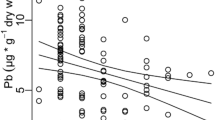Abstract
Previous work by our group has shown bioaccumulation of contaminants and alterations in the immune system of hispid cotton rats (Sigmodon hispidus) inhabiting petrochemical waste sites (landfarms). We studied populations of cotton rats inhabiting petrochemical landfarms or uncontaminated reference sites. Cotton rat populations inhabiting abandoned landfarms experienced reduced summer population densities and lower mean monthly survival, with maximum densities 65% that of populations inhabiting non-contaminated grassland (reference) sites. Survival was lower in populations from landfarms (0.62±0.04) compared to reference sites (0.75±0.04), with differences most notable during summer months. Cotton rat populations sampled from landfarms had even sex ratios and a lower proportion of juveniles compared to populations from reference sites. No differences were observed in the weight of epididymides, testes, uteri, or ovaries, and no differences in fecundity were detected among sites.



Similar content being viewed by others
References
Batty J., R.A. Leavitt, N. Biondo, D. Polin, 1990. An ecotoxicological study of population of the white footed mouse (Peromyscus leucopus) inhabiting a polychlorinated biphenyls-contaminated area Arch. Environ. Contam. Toxicol. 19:283–290
Burnham, K., Anderson, D. R., White, G.C., Brownie, C. and Pollock, K. H. (1987). Design and analysis methods for fish survival experiments based on release-capture. Am. Fish. Soc. Monogr. 5
Carlson R.I., J.A. Wilson, J.L. Schroder, N.T. Basta, R.L. Lochmiller, D.M. Janz, 2003. Ecotoxicological risks associated with land treatment of petrochemical wastes: II. Effects on hepatic Phase I and Phase II detoxification enzymes in cotton rats J. Toxicol. Environ. Health 66:23–29
Christian J.J., 1950. The adreno-pituitary system and population cycles in mammals J. Mammal. 31:247–259
Congdon J.D., A.E. Dunham, W.A. Hopkins, C.L. Rowe, T.G. Hinton, 2001. Resource allocation-based life histories: a conceptual basis for studies of ecological toxicology Environ. Toxicol. Chem. 20:1698–1703
Dmowski K., A. Kozakiewicz, M. Kozakiewicz, 1998. Small mammal populations and community under conditions of extremely high thallium contamination in the environment Ecotox. Environ. Safe. 41:2–7
Elangbam C.S., C.W. Qualls Jr., R.L. Lochmiller, J. Novak, 1989. Development of the cotton rat (Sigmodon hispidus) as a biomonitor of environmental contamination with emphasis on hepatic cytochrome P-450 induction and population characteristics Bull. Environ. Contam. Toxicol. 42:482–488
Garten C.T., 1980. Ingestion of soil by hispid cotton rats, white-footed mice, and eastern chipmunks J. Mammal. 61:136–137
Hestbeck J.B., 1986. Multiple regulation states in populations of the California vole Microtus californicus Ecol. Monogr. 56:161–181
Krebs C. J., J.H. Meyers, 1974. Population cycles in small mammals Adv. Ecol. Res. 8:267–399
Lauckhart J.B., 1957. Animal cycles and food J. Wildlife Manage. 21:230–234
Lochmiller R.L., 1996. Immunocompetence and animal population regulation Oikos 76:594–602
Lochmiller R.L., C. Deerenberg, 2001. Trade-offs in evolutionary immunology: just what is the cost of immunity? Oikos 88:87–98
McMurry S.T., R.L. Lochmiller, K. McBee, C.W. Qualls Jr., 1999. Indicators of immunotoxicity in populations of cotton rats (Sigmodon hispidus) inhabiting an abandoned oil refinery Ecotox. Environ. Safe. 42:223–235
Mihok S., T. Lawton, B. Swartz, 1988. Fates and movements of meadow voles (Microtus pennsylvanicus) following a population decline Can. J. Zool. 66:323–328
Odum E.P., 1955. An eleven year history of a Sigmodon population J. Mammal. 36:368–378
Pitelka F.A., 1957. Some aspects of population structure in the short-term cycle of the brown lemming in northern Alaska Cold Spring Harb. Symp. Quant. Biol. 22:237–251
Pollock K.H., 1982. A capture-recapture design robust to unequal probability of capture J. Wildlife Manage. 46:757–760
Rolan R.G., H.T. Gier, 1967. Correlation of embryo and placental scar counts of Peromyscus maniculatus and Microtus ochrogaster J. Mammal. 48:317–319
Rose R.K., R.D. Dueser, 1980. Lifespan of Virginia meadow voles J. Mammal. 61:760–763
Rowley M.H., J.J. Christian, D.K. Basu, M.A. Pawlikowski, B. Paigen, 1983. Use of small mammals (voles) to assess a hazardous waste site at Love Canal, Niagara Falls, NY Arch. Environ. Contam. Toxicol. 12:383–397
SAS Institute, Inc. (1996). Statistical Aanalysis System (SAS) User’s Guide: Statistics, version 6. SAS Institute Inc. Clay, North Carolina, 1686 pp
Schroder J.L., N.T. Basta, M. Payton, J.A. Wilson, R.I. Carlson, D.M. Janz, R.L. Lochmiller, 2003. Ecotoxicological risks associated with land treatment of petrochemical wastes: I Residual soil contamination and bioaccumulation by cotton rats (Sigmodon hispidus) J. Toxicol. Environ. Health 66:1–21
Shelford V.E., 1943. The abundance of collared lemming (Dicrostonyx groenlandicus (Tr.) var. richardsoni mer) in the Churchill area, 1929–1940 Ecology 24:472–484
Swiergosz R., M. Zakrzewska, K. Sawicka-Kapusta, K. Bacia, I. Janowska, 1998. Accumulation of cadmium in its effect on bank vole tissues after chronic exposure Ecotox. Environ. Safety 41:130–136
White G.C., K.P. Burnham, 1999. Program MARK: survival estimation from populations of marked animals Bird Study 46(Supplement): 120–138
Wilson J.A., R.I. Carlson, J.L. Schroder, N.T. Basta, D.M. Janz, R.L. Lochmiller, 2003. Ecotoxicological risks associated with land treatment of petrochemical wastes: III. Immune function and hematology of cotton rats J. Toxicol. Environ. Health 66:41–59
Wilson J.A., R.L. Lochmiller, D.M. Janz, 2004. Dynamics of rodent assemblages inhabiting abandoned petroleum landfarms in Oklahoma Ecol. Appl. 14:1016–1027
Acknowledgments
The research in this manuscript was funded by USEPA, Office of Research and Development, grant R826242-01-0. However, it has not been subjected to the Agency’s required peer and policy review and therefore does not necessarily reflect the views of the Agency and no official endorsement should be inferred. We thank Gary White, Dave Anderson, and Ken Burnham for their help in developing models for use in program MARK, and Dan Rafferty, Eric Webb, Terry Coffey, Karen Anderson, and Charlotte Deerenberg for their help in trapping.
Author information
Authors and Affiliations
Corresponding author
Additional information
Deceased
Rights and permissions
About this article
Cite this article
Wilson, J.A., Lochmiller, R.L. & Janz, D.M. Population Dynamics of Cotton Rats (Sigmodon hispidus) Inhabiting Abandoned Petroleum Landfarms in Oklahoma, USA. Ecotoxicology 15, 19–30 (2006). https://doi.org/10.1007/s10646-005-0053-1
Accepted:
Published:
Issue Date:
DOI: https://doi.org/10.1007/s10646-005-0053-1




